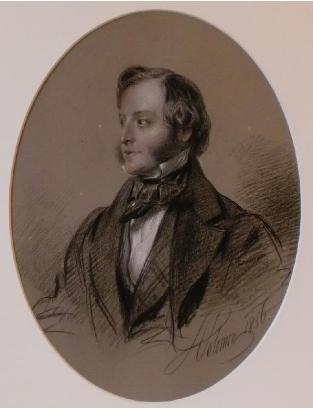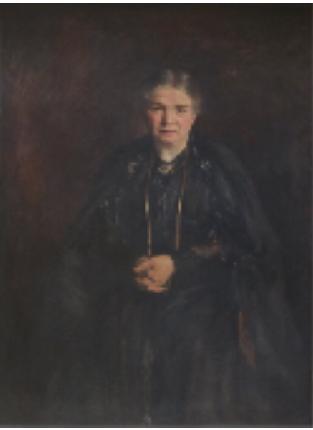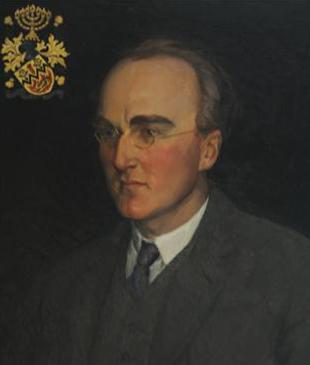Sarah Joseph, née Edwards [1846-1936], c 1914 My great-grandmother is an enigma and it has cost me dear in hours spent on research which could have been avoided if, in my first 46 years, I had shown the slightest interest in my family and asked my mother about her … From time to time I wondered if I had found the wrong birth certificate, but when doing further research I came on a black and white photo of a portrait of her and she did not look very Jewish. This autumn I located the branch of Sarah’s family that owned the painting which I had last seen at the house of her youngest daughter in the seventies; now having seen it again she is clearly not Jewish. What I do know can be found under Sitters E-K and a biography of the portraitist I M Cohen, unrelated to me, under Painters A-D. |
|
|||
Arthur Green [fl 1847-c 1904], 1856 Abraham Solomon [1823-62]: of the possible Arthur Greens, this is most likely to be of the architect, who appears to have died in 1904. He worked with his partner Thomas Archer on many buildings in the 1870s and 1880s including Whitehall Court and the interior of the Cafe Royal. He may even have met Abraham Solomon at the Academy Schools. For more information see Abraham Solomon. Courtesy of Scott Thomas Buckle. |
 |
|||
Found!
Redcliffe Salaman [1874-1955]
|
Redcliffe Salaman, by Chattie Salaman. Courtesy of NIAB. |
My great-uncle Redcliffe was the ninth of the fifteen children of Myer Salaman and Sarah Solomon and his is the first of my missing portraits to be found. It is in the board room of the NIAB, successor to the Potato Virus Research Institute (see below). It is by his sister-in-law Chattie.
He qualified in medicine at the London Hospital in 1900, and the following year went to Wurzburg and Berlin to study and married Pauline Ruth (Nina) Davis, a minor but distinguished poet.
In 1903 he became director of the Pathological Institute at the London Hospital and the following year he obtained his MD. That year he also contracted tuberculosis and had to give up medicine. After six months in a Swiss sanatorium he bought a house in Barley, Hertfordshire, to rest in countryside. There he turned his restless mind to a different, but none the less related, set of scientific problems. By 1908 he had established the genetic nature of resistance to the imfamous potato blight, which eventually resulted in the introduction of potatoes resistant to blight by crossing with the wild potato.
This work was interrupted by World War I. Joining the Royal Army Medical Corps he served in Palestine, writing about his experiences there in Palestine Regained (1919).
In 1926 he and a friend convinced the Ministry of Agriculture to found an institute in Cambridge to investigate viral diseases of potatoes. Salaman was appointed director of the Potato Virus Research Institute, where he stayed until he retired in 1939.
He was elected to the Royal Society in 1935. His overriding interest remained the potato and its role in history. After many years collecting material he wrote his much reprinted History and Social Influence of the Potato (1949) which has never been out of print.
The humane concerns of his book were even more evident in his work to support the Jewish community. While at the London Hospital he also worked as a social worker among Jews in the East End.
In 1933 he was a founding member of the Academic Assistance Council (later the Society for the Protection of Science and Learning), which enabled academic refugees from Germany to find work in Britain. He also assisted other refugees by founding the Jewish Professional Committee. More important, he was the first chairman of the Jewish committee for relief abroad, which in 1945 set out to organise the task of rehabilitating any survivors of the extermination camps after the defeat of Germany. After the war Salaman was also involved in the establishment of the Hebrew University in Jerusalem, of which he then became an influential governor. He also served as president of the Jewish Health Organisation of Great Britain and Jewish Historical Society of England.
His favourite daughter, Ruth (Collett) was at the Slade with my mother and his three grand sons-in-law included Jonathan Miller (playwright, actor, producer, doctor), and Karl Miller (but no relation), Literary Editor of the Spectator, and New Statesman, editor of The Listener and founder of the London Review of Books.



